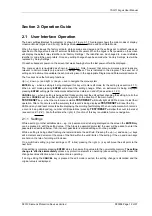
7SG11 Argus User Manual
©2013 Siemens Protection Devices Limited
P20006 Page 26 of 37
to initiate a trip when fault current flows away from the busbar. (For an incomer, this requires a parallel supply
source).
In both cases therefore, the ‘FORWARD’ direction is the trip direction for normal applications.
Argus 2 and 6 protection elements can be programmed to trip either NON directional, FORWARD, REVERSE or
both (TRI-STATE operation). The FWD and REV (TRI-STATE operation) settings can be user programmed
independently to different sets of setting values.
Phase Directional Element
Using a phase-sequence indicator, first check that the phase sequence of the voltages at the Argus are correct
i.e. A-B-C and see by inspection that the phasing of the connections to the Argus is correct.
If system has reverse Phase rotation i.e. A-C-B this will affect the Phase Fault directional elements only.
For correct phasing of Type 1 Directional Relays i.e. AG2 – XXX series,
reverse V
bc
i.e. connect voltage V
b
to terminal
83 and V
c
to terminal 82.
For correct phasing of Type 2 Directional Relays i.e. AG –5XX series,
connect as shown in figures 4 – 10 /11/12/13 for normal A-B-C rotation; no wiring changes are
necessary as the required adjustment is performed internally by the Relay in response to the
Phase rotation setting change given below.
change the rotation setting in
SystemConfig:Phase Rotation
from
A-B-C
to
A-C-B
.
Setting to
A-C-B
automatically changes ‘
Forward
’ to ‘
Reverse
’ and visa-versa.
Earth Fault connections remain unchanged, i.e. connections as shown.
Check the magnitudes of the voltage transformer voltages.
Pass a three phase load current of 20% or more of the current transformer rating in a known direction. From the
‘Instruments Display Mode’ check that the Argus correctly indicates either ‘FORWARD’ or ‘REVERSE’, in line with
the direction of flow of the primary current.
If the flow of current is such that the Argus should operate, see that in fact it does operate. Note that it may be
necessary to reduce the current setting to a level below the available three phase load current. Reverse the
connections to the current coils and see that the Argus restrains.
If the flow of current is such that the Argus should restrain, see that in fact it does restrain, then reverse the
connections to the current coils and see that it operates.
This test is based on the assumption that the load current has a normal power factor. If, however, the power
factor is very low, leading or lagging, difficulties may be encountered. For example, a very low leading power
factor with power in the forward direction may cause a quadrature connected protection to restrain.
When the test is complete all connections must be restored to normal. If any settings have been changed in
proving the direction restore them to the original settings and repeat secondary injection testing as considered
necessary.
Earth Directional Element
If the application includes a directional earth element, polarised in the normal fashion from the open delta winding
of a voltage transformer, then the following procedure should be followed:-
Disconnect the A phase primary input to the voltage transformer. Where primary fuses exist this can be done by
removing the A phase fuse.
Short circuit the A phase main secondary winding. This should be done on the load side of the V.T. secondary
circuit protection (eg fuse or miniature circuit breaker - MCB).
Short circuit and disconnect the current transformer secondary winding connections on the B and C phases.
Energise the circuit with primary load current (eg 20% of In).
If the load power is flowing away from the busbars, then the directional earth fault element should indicate
operation in the forward zone. Check that this is the case. Reverse the connections either to the current or voltage
input and check for operation in the reverse zone.
If the load power is flowing toward the busbars, then the opposite results should be expected.
Finally, de-energise the circuit, restore normal connections, replace the A phase primary fuse and remove the
shorting connections from the A phase V.T. and from the B and C phase C.T. connections.
Figure 4-8 shows the test set-up and the resultant applied voltages and currents for a simulated earth fault
condition using load current.






























